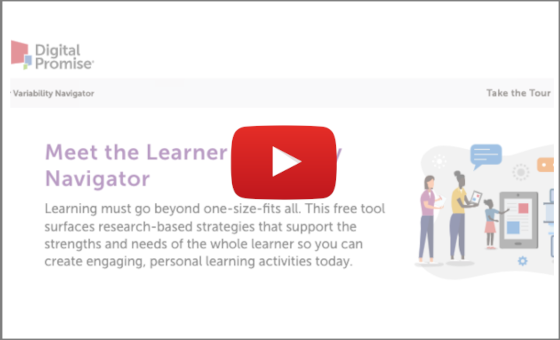Take the Tour of the Navigator
This tour highlights the Navigator’s key features step-by-step so you can find the research-based factors and strategies that best support your learners.
Get an overview of how to leverage the science of learning to support the whole learner.
1. Choose a Model
that represents your area of interest.
2. Identify factors
that you want to address in your product or classroom.
3. Get strategies
that you can apply now to reach more learners.
Math PK-2 Model
This model presents the science of learner variability in Math for grades PK-2. It identifies the factors that are critical to learner success at this stage and the strategies to help you purposefully support each learner.
Math PK-2 Factors
Research has identified which factors are critical to learner success for Math PK-2; you select which of those to address.
Math PK-2 Strategies
Based on the factor(s) you select, get research-based strategies and resources to help you design products or lessons that reach each learner.
Math 3-6 Model
This model presents the science of learner variability in Math for grades 3-6. It identifies the factors that are critical to learner success at this stage and the strategies to help you purposefully support each learner.
Math 3-6 Factors
Research has identified which factors are critical to learner success for Math 3-6; you select which of those to address.
Math 3-6 Strategies
Based on the factor(s) you select, get research-based strategies and resources to help you design products or lessons that reach each learner.
Math 7-10 Model
This model presents the science of learner variability in Math for grades 7-10. It identifies the factors that are critical to learner success at this stage and the strategies to help you purposefully support each learner.
Math 7-10 Factors
Research has identified which factors are critical to learner success for Math 7-10; you select which of those to address.
Math 7-10 Strategies
Based on the factor(s) you select, get research-based strategies and resources to help you design products or lessons that reach each learner.
Literacy PK-3 Model
This model presents the science of learner variability in Literacy for grades PK-3. It identifies the factors that are critical to learner success at this stage and the strategies to help you purposefully support each learner.
Literacy PK-3 Factors
Research has identified which factors are critical to learner success for Literacy PK-3; you select which of those to address.
Literacy PK-3 Strategies
Based on the factor(s) you select, get research-based strategies and resources to help you design products or lessons that reach each learner.
Literacy 4-6 Model
This model presents the science of learner variability in Literacy for grades 4-6. It identifies the factors that are critical to learner success at this stage and the strategies to help you purposefully support each learner.
Literacy 4-6 Factors
Research has identified which factors are critical to learner success for Literacy 4-6; you select which of those to address.
Literacy 4-6 Strategies
Based on the factor(s) you select, get research-based strategies and resources to help you design products or lessons that reach each learner.
Literacy 7-12 Model
This model presents the science of learner variability in Literacy for grades 7-12. It identifies the factors that are critical to learner success at this stage and the strategies to help you purposefully support each learner.
Literacy 7-12 Factors
Research has identified which factors are critical to learner success for Literacy 7-12; you select which of those to address.
Literacy 7-12 Strategies
Based on the factor(s) you select, get research-based strategies and resources to help you design products or lessons that reach each learner.
Portrait of a Learner PK-3 Model
This model presents the science of learner variability for grades PK-3 for learning 21st-Century Skills. It identifies the factors that are critical to learner success at this stage and the strategies to help you purposefully support each learner.
Portrait of a Learner PK-3 Factors
Research has identified which factors are critical to 21st-Century learner success for PK-3 learners; you select which of those to address.
Portrait of a Learner PK-3 Strategies
Based on the factor(s) you select, get research-based strategies and resources to help you design products or lessons that reach each learner.
Portrait of a Learner 4-8 Model
This model presents the science of learner variability for grades 4-8 for learning 21st-Century Skills. It identifies the factors that are critical to learner success at this stage and the strategies to help you purposefully support each learner.
Portrait of a Learner 4-8 Factors
Research has identified which factors are critical to 21st-Century learner success for 4-8 learners; you select which of those to address.
Portrait of a Learner 4-8 Strategies
Based on the factor(s) you select, get research-based strategies and resources to help you design products or lessons that reach each learner.
Portrait of a Learner 9-12 Model
This model presents the science of learner variability for grades 9-12 for learning 21st-Century Skills. It identifies the factors that are critical to learner success at this stage and the strategies to help you purposefully support each learner.
Portrait of a Learner 9-12 Factors
Research has identified which factors are critical to 21st-Century learner success for 9-12 learners; you select which of those to address.
Portrait of a Learner 9-12 Strategies
Based on the factor(s) you select, get research-based strategies and resources to help you design products or lessons that reach each learner.
Adult Learner Model
This model presents the science of learner variability for Adult Learners. It identifies the factors that are critical to learner success at this stage and the strategies to help you purposefully support each learner.
Adult Learner Factors
Research has identified which factors are critical to learner success for Adult Learners; you select which of those to address.
Adult Learner Strategies
Based on the factor(s) you select, get research-based strategies and resources to help you design products or lessons that reach each learner.








